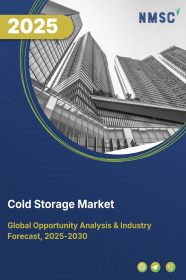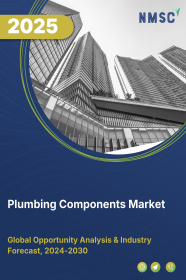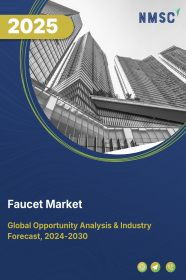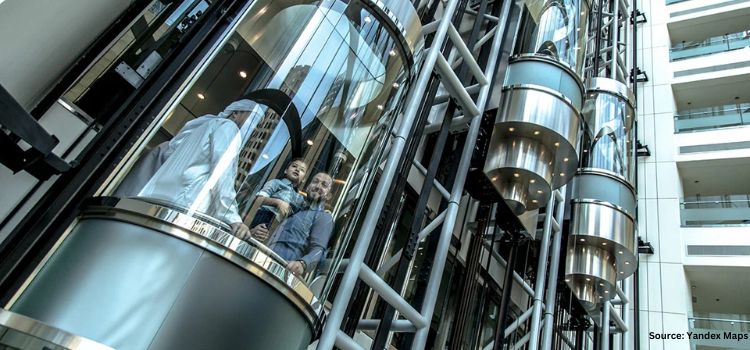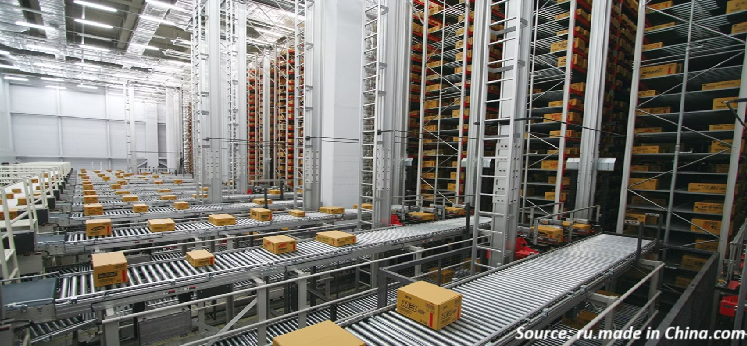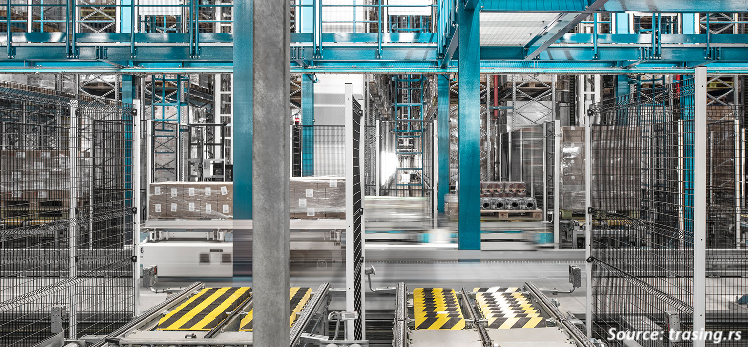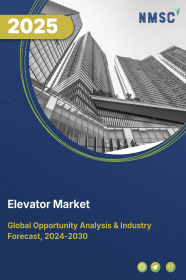
Elevator Market by Type (Passenger Elevator, Freight Elevator and Others), by Technology (Traction and Hydraulic), by Service (New Installation, Maintenance and Modernization), by Capacity (Less than 1500 kg, 1500 to 2500 kg, 2501 to 4000 kg and more than 4000 kg) by Speed (Less than 1 M/S, Between 1 to 4 M/S and More than 5 M/S) and Others – Global Opportunity Analysis and Industry Forecast, 2024 –2030
Industry: Construction & Manufacturing | Publish Date: 11-Mar-2025 | No of Pages: 483 | No. of Tables: 407 | No. of Figures: 382 | Format: PDF | Report Code : CM1409
US Tariff Impact on Elevator Market
Trump Tariffs Are Reshaping Global Business
Elevator Market Overview
The Elevator Market size was valued at USD 93.64 billion in 2024 and is predicted to reach USD 137.57 billion by 2030, with a CAGR of 5.8% from 2025 to 2030.
The worldwide elevator sector is expanding due to the rise in urbanization and the growing need for high rise buildings across various regions. Also, the growth in residential, commercial and industrial sectors is driving demand for effective vertical transportation systems. However, issues such as high installation and maintenance expenses restrict the overall growth of the market.
Meanwhile, the incorporation of advanced technology along with advent of energy saving elevator systems provides a wider avenue for future growth. Prominent participants in the industry include Otis, Schindler and KONE are adopting design innovation and technological change, along with strategic alliances and mergers and acquisitions to hold their market position. Further, the shift towards modernization and retrofitting traditional elevator systems drive the elevator market growth with increased energy efficiency, safety and convenience to the users.
Global urbanization increases the demand for elevators
Rapid urbanization is driving the demand for high and tall buildings in both residential and commercial sectors. As cities tends to meet increasing population, governments and private developers invest in mega scale infrastructure projects such as skyscrapers, metro stations and other developments.
According to the UN Population Division, the population living in urban areas all over the world is counted as 4.61 billion in 2023 with a rise of 2.2 percent compared to last year. This rise in number of urban populations requires the installation of elevators to facilitate efficient vertical transport that improves the accessibility and convenience.
Rising Government Investments in Smart Cities
Governments across the globe are heavily investing in smart city schemes that emphasize sustainable urban development, cutting edge infrastructure and better public services. Smart city schemes tend to incorporate high and tall buildings, metro stations and airports all of which demand advanced elevator systems.
The Federal Transit Administration of the U.S. Department of Transportation invested an USD 343 million in federal funding in eight transit systems in eight states in 2024. This will be used to upgrade facilities such as elevators, platform remodeling and enhanced signage in several rail stations that enhances access to critical destinations for millions of Americans.
High costs associated with elevator installations and maintenance hinder the market growth
High installation, maintenance and modernization costs significantly restrain the elevator market expansion. The high upfront cost, especially for non-elevator-specific buildings, acts as a burden to owners and developers. Ongoing maintenance and modernization demand to achieve efficiency and safety measures add to the cost factor. These expenses are particularly deterrents in low-income regions or vintage buildings with sophisticated retrofitting, limiting market development.
Introduction of AI-Powered Predictive Elevator Maintenance Creates Opportunity
The integration of IoT and AI technologies is expected to expand, offering even smarter, more efficient systems that can predict maintenance needs and optimize building traffic in real time. As technological advancements continue to evolve it present significant future growth opportunities for the elevator sector.
In November 2024, Otis Electric launched the Otis Electric 7000 elevator, a smart elevator designed for new construction and modernization projects that features advanced safety features and integration with AI-powered technologies.
Asia Pacific Dominates Elevator industry, with the highest projected CAGR till 2030
The rising urbanization in the region especially in nations such as China, India and Japan are a major propeller for the expansion of elevator market trends. As urban population rises there is a growing need for tall and high buildings like residential complexes and commercial office buildings.
This increases the extensive use of elevators to ensure efficient vertical transportation within these buildings. Based on the UN Population Division, the Chinese urban population is considered 910.90 million for 2023 compared to India with close to 522.94 million citizens.
The presence of leading elevator manufacturers such as Otis, Schindler and Mitsubishi Electric significantly influences the growth of the elevator market demand in the region.
These key players continuously drive innovation through the development of advanced elevator technologies including energy efficient systems, smart elevators and IoT enabled solutions.
In August 2024, Otis Indonesia launched the Gen3 digitally connected elevator which integrates advanced technology to enhance user experience and operational efficiency. This elevator features digital connectivity that allows real time monitoring and predictive maintenance.
Competitive Landscape
The elevator industry comprises various market players, such as Schindler, Otis Elevator Company, TK Elevator (TKE), Kone Corporation, Hitachi Ltd., Fujitec Co., Ltd, Hyundai Elevator Co., Ltd, Mitsubishi Electric Corporation, Toshiba Elevator and Building Systems Corporation, Winone Elevator Company Limited, Johnson Lifts Private Limited, Aaron Elevators, Escon Elevators, Stannah Lifts, Elite Elevators, Epic Elevators, Aquarius Germany GmbH, Schmitt Elevators, Koehler Elevators, Canny Elevator Co., Ltd. and others.
These market players are adopting various strategies such as partnership and product launches across various regions to maintain their dominance in the market.
|
Date |
Company |
Recent Developments |
|
February 2025 |
TK Elevator |
TK Elevator and Alat partnered to manufacture end-to-end elevator and escalator solutions in Saudi Arabia. This partnership aims to establish a strong local presence for the production and supply of elevators and escalators in Saudi Arabia. |
|
January 2025 |
Kone Corporation |
KONE Australia has launched the High-Rise MiniSpace DX, a next-generation elevator solution that optimizes space and enhances people flow in high-rise buildings, featuring improved energy efficiency and performance. |
|
December 2024 |
Fujitec Co., Ltd. |
Fujitec Co., Ltd. will launch Ele Glance, a new standard elevator model, in spring 2025. Ele Glance succeeds Fujitec’s XIOR model and has enhanced capabilities in design, maintenance, and disaster response. It has 29 color options for ceiling, wall, and floor materials, and its interior space follows the CMF design framework. |
|
December 2024 |
Kone Corporation |
KONE India has launched its KONE I MonoSpace SMART, KONE I MiniSpace SMART and KONE A MonoSpace SMART elevator series which comply with the new IS 17900 safety standards. |
|
November 2024
|
Otis Elevator Company |
Otis launched a smart elevator designed for both new construction projects and modernization efforts, enhancing efficiency and user experience. This innovative elevator system integrates advanced technology to provide seamless operation, improved safety, and enhanced passenger comfort. |
|
May 2024 |
Mitsubishi Electric Corporation |
Mitsubishi Electric Building Solutions Corporation (MEBS) launched the NEXIEZ-Fit elevator. It's a new standard model designed for low-rise residential buildings in areas with growing populations like ASEAN and the Middle East |
Key Market Segments
By Type
-
Passenger Elevator
-
Freight Elevator
-
Others
By Technology
-
Traction
-
Machine Room [MR] Traction
-
Machine Roomless [MRL] Traction
-
-
Hydraulic
By Service
-
New Installation
-
Maintenance
-
Modernization
By Capacity
-
Less than 1500 kg
-
1500 to 2500 kg
-
2501 to 4000 kg
-
More than 4000 kg
By Speed
-
Less than 1 M/S
-
Between 1 to 4 M/S
-
More than 5 M/S
By Deck Type
-
Single Deck
-
Double Deck
By Designation Control
-
Smart
-
Conventional
By Door Type
-
Automatic
-
Manual
By Application
-
Residential
-
Commercial
-
Industrial
By Region
-
North America
-
The U.S.
-
Canada
-
Mexico
-
-
Europe
-
The UK
-
Germany
-
France
-
Italy
-
Spain
-
Denmark
-
Netherlands
-
Finland
-
Sweden
-
Norway
-
Russia
-
Rest of Europe
-
-
Asia-Pacific
-
China
-
Japan
-
India
-
South Korea
-
Australia
-
Indonesia
-
Singapore
-
Taiwan
-
Thailand
-
Rest of Asia-Pacific
-
-
Rest of World
-
Latin America
-
Middle East
-
Africa
-
Key Market Players
-
Schindler
-
Otis Elevator Company
-
TK Elevator (TKE)
-
Kone Corporation
-
Hitachi Ltd.
-
Fujitec Co., Ltd.
-
Hyundai Elevator Co., Ltd.
-
Mitsubishi Electric Corporation
-
Toshiba Elevator and Building Systems Corporation
-
Winone Elevator Company Limited
-
Johnson Lifts Private Limited
-
Aaron Elevators
-
Escon Elevators
-
Stannah Lifts
-
Elite Elevators
-
Epic Elevators
-
Aquarius Germany GmbH
-
Schmitt Elevators
-
Koehler Elevators
-
Canny Elevator Co., Ltd.
|
Parameters |
Details |
|
Market Size in 2024 |
USD 93.64 billion |
|
Revenue Forecast in 2030 |
USD 137.57 billion |
|
Growth Rate |
CAGR of 5.8%from 2025 to 2030 |
|
Analysis Period |
2024–2030 |
|
Base Year Considered |
2024 |
|
Forecast Period |
2025–2030 |
|
Market Size Estimation |
Billion (USD) |
|
Growth Factors |
|
|
Countries Covered |
28 |
|
Companies Profiled |
20 |
|
Market Share |
Available for 10 companies |
|
Customization Scope |
Free customization (equivalent to up to 80 working hours of analysts) after purchase. Addition or alteration to country, regional, and segment scope. |
|
Pricing and Purchase Options |
Avail customized purchase options to meet your exact research needs. |

















 Speak to Our Analyst
Speak to Our Analyst



